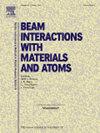Performance evaluation of the SPES FEBIAD ion source
IF 1.4
3区 物理与天体物理
Q3 INSTRUMENTS & INSTRUMENTATION
Nuclear Instruments & Methods in Physics Research Section B-beam Interactions With Materials and Atoms
Pub Date : 2025-03-25
DOI:10.1016/j.nimb.2025.165688
引用次数: 0
Abstract
SPES (Selective Production of Exotic Species) is the Radioactive Ion Beam (RIB) facility that is currently in the installation phase at the Istituto Nazionale di Fisica Nucleare in the Laboratori Nazionali di Legnaro (LNL-INFN). The main purpose of the facility is to deliver neutron-rich radioactive beams with a range of mass between 60 and 160 amu produced as fission products originated within a Uranium Carbide (UCx) target impinged by high energy protons (40–70 MeV). In the last few years, the SPES group and their collaborators have focused on multiple aspects: development of various ISOL targets, ion sources, a high-power beam dump, versatile Front-End designs, primary proton beam and RIB diagnostics, design of beam optic components, and remote target handling. The development and optimization of ionization sources represents one of the most important R&D activities. The collaboration between SPES and ISOLDE (CERN) groups has enabled the evaluation of the performances of a novel FEBIAD ion source taking advantage of the ISOLDE off-line Front-End. In this paper, the results of efficiency and transversal emittance measurements of the new SPES FEBIAD ion source are presented and discussed. Particular attention is dedicated to the description of the experimental setup and to the comparison of experimental data with simulation to promote the reproducibility of the experimental tests with other types of sources.
SPES FEBIAD源的性能评价
SPES(选择性生产外来物种)是放射性离子束(RIB)设施,目前正在国家核工业研究所的国家实验室Legnaro (LNL-INFN)安装阶段。该设施的主要目的是提供富含中子的放射性光束,其质量范围在60至160 amu之间,由高能质子(40-70 MeV)撞击碳化铀(UCx)目标产生的裂变产物产生。在过去的几年里,spe小组和他们的合作者专注于多个方面:各种ISOL靶标的开发,离子源,高功率光束堆,多功能前端设计,主质子束和RIB诊断,光束光学元件的设计,以及远程目标处理。电离源的开发和优化是最重要的研发活动之一。SPES和ISOLDE (CERN)小组之间的合作已经能够评估利用ISOLDE离线前端的新型FEBIAD离子源的性能。本文介绍并讨论了新型SPES FEBIAD离子源的效率和横向发射度测量结果。特别注意实验设置的描述和实验数据与模拟的比较,以促进与其他类型来源的实验测试的可重复性。
本文章由计算机程序翻译,如有差异,请以英文原文为准。
求助全文
约1分钟内获得全文
求助全文
来源期刊
CiteScore
2.80
自引率
7.70%
发文量
231
审稿时长
1.9 months
期刊介绍:
Section B of Nuclear Instruments and Methods in Physics Research covers all aspects of the interaction of energetic beams with atoms, molecules and aggregate forms of matter. This includes ion beam analysis and ion beam modification of materials as well as basic data of importance for these studies. Topics of general interest include: atomic collisions in solids, particle channelling, all aspects of collision cascades, the modification of materials by energetic beams, ion implantation, irradiation - induced changes in materials, the physics and chemistry of beam interactions and the analysis of materials by all forms of energetic radiation. Modification by ion, laser and electron beams for the study of electronic materials, metals, ceramics, insulators, polymers and other important and new materials systems are included. Related studies, such as the application of ion beam analysis to biological, archaeological and geological samples as well as applications to solve problems in planetary science are also welcome. Energetic beams of interest include atomic and molecular ions, neutrons, positrons and muons, plasmas directed at surfaces, electron and photon beams, including laser treated surfaces and studies of solids by photon radiation from rotating anodes, synchrotrons, etc. In addition, the interaction between various forms of radiation and radiation-induced deposition processes are relevant.

 求助内容:
求助内容: 应助结果提醒方式:
应助结果提醒方式:


